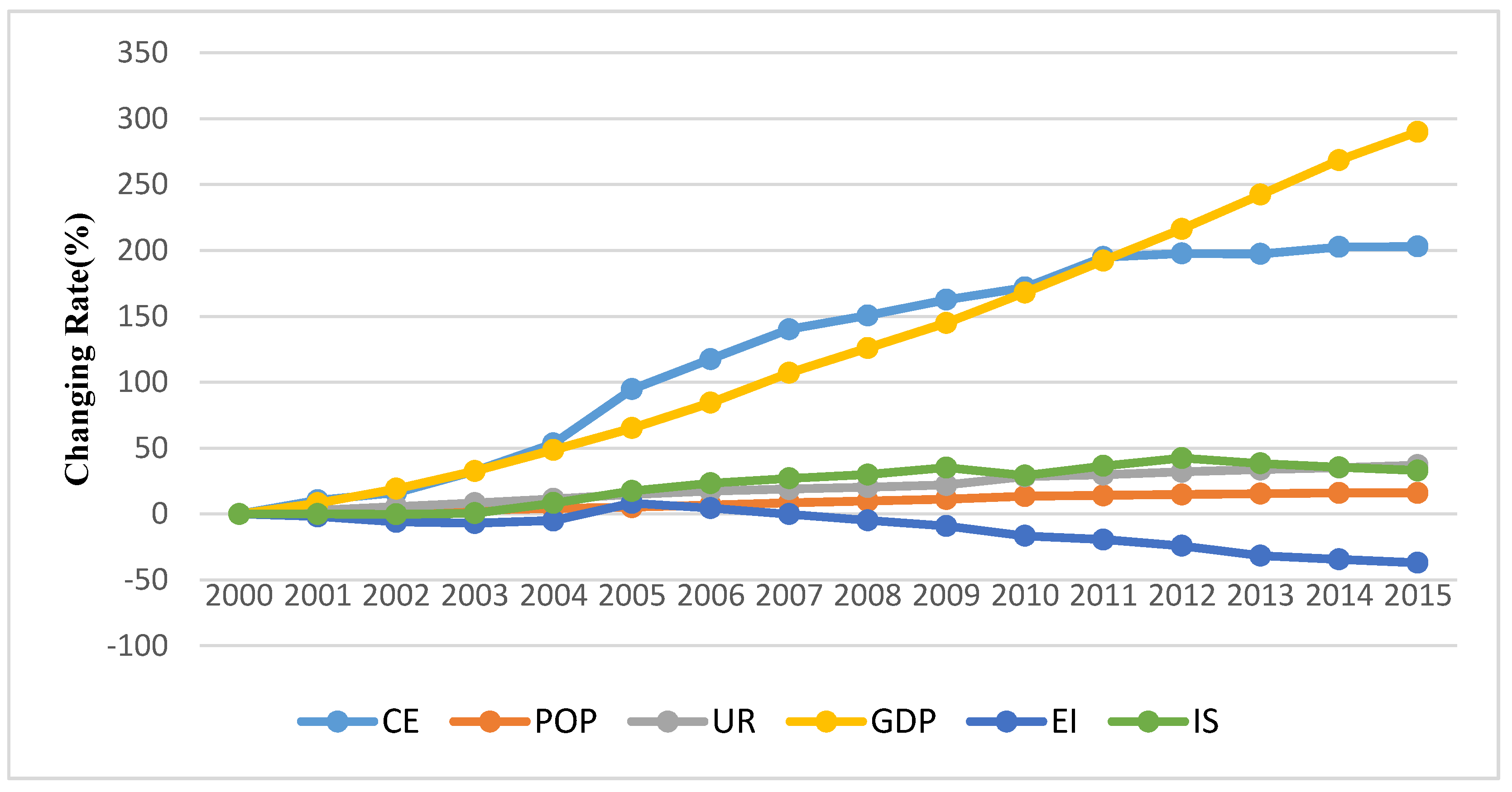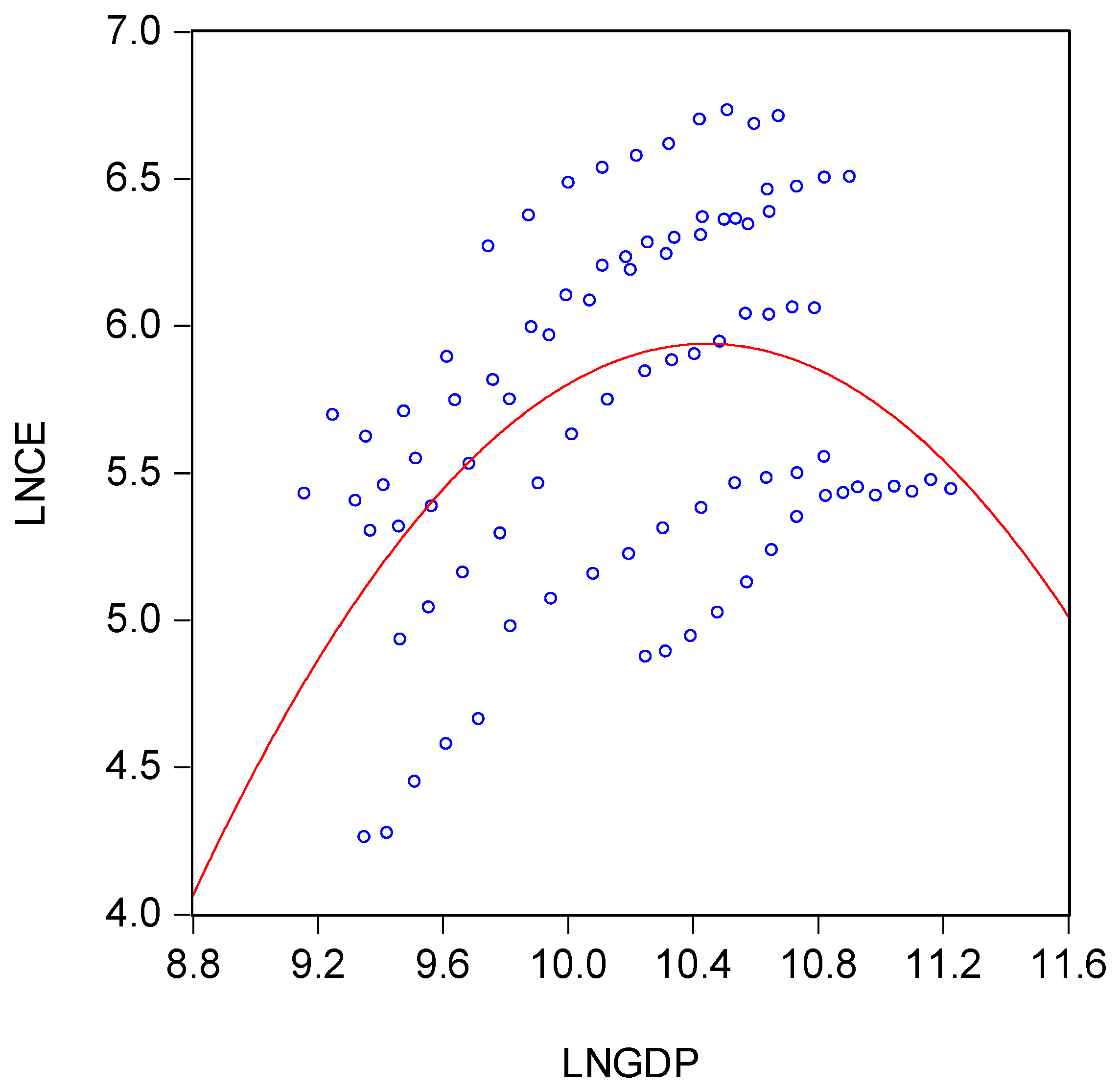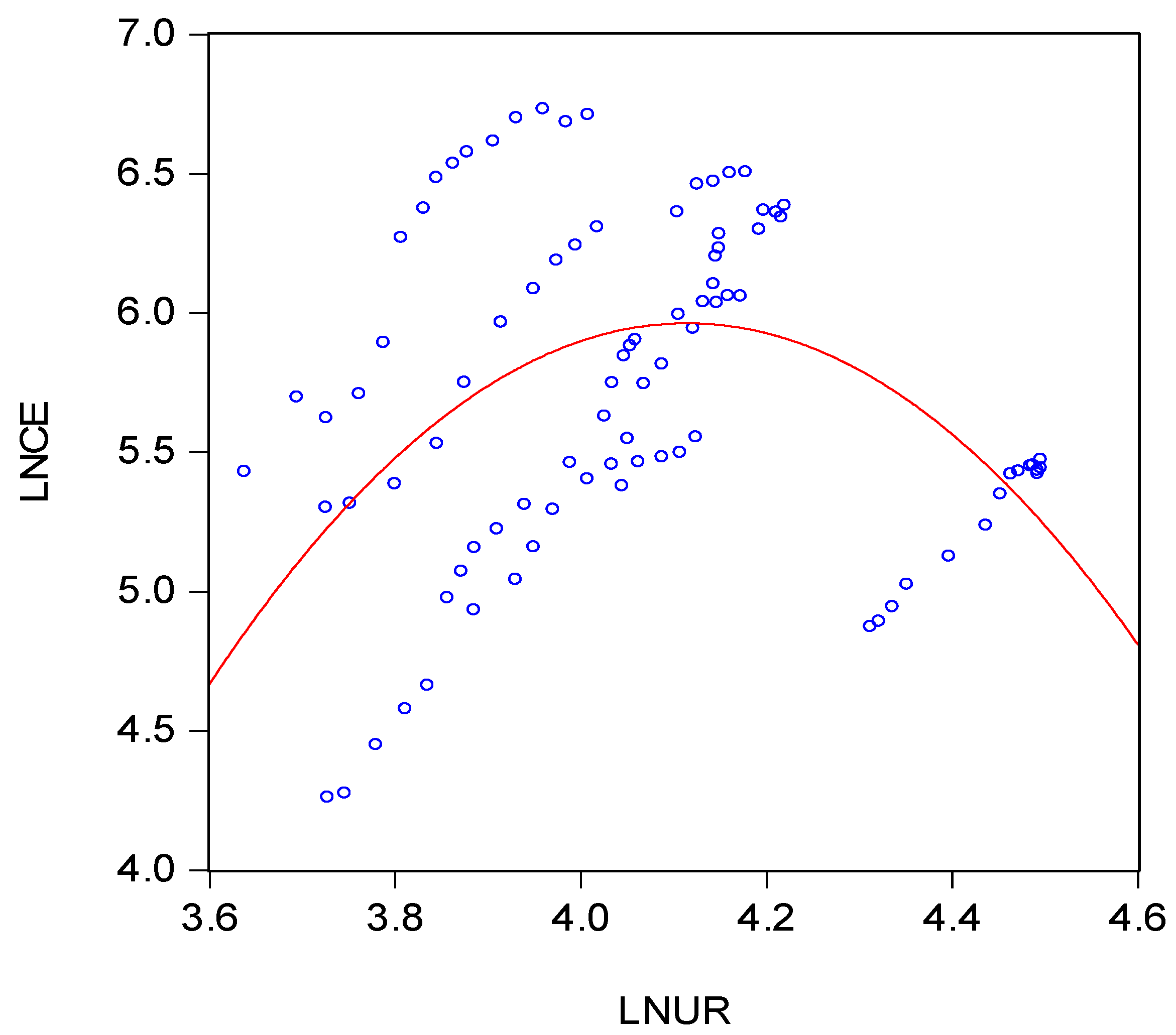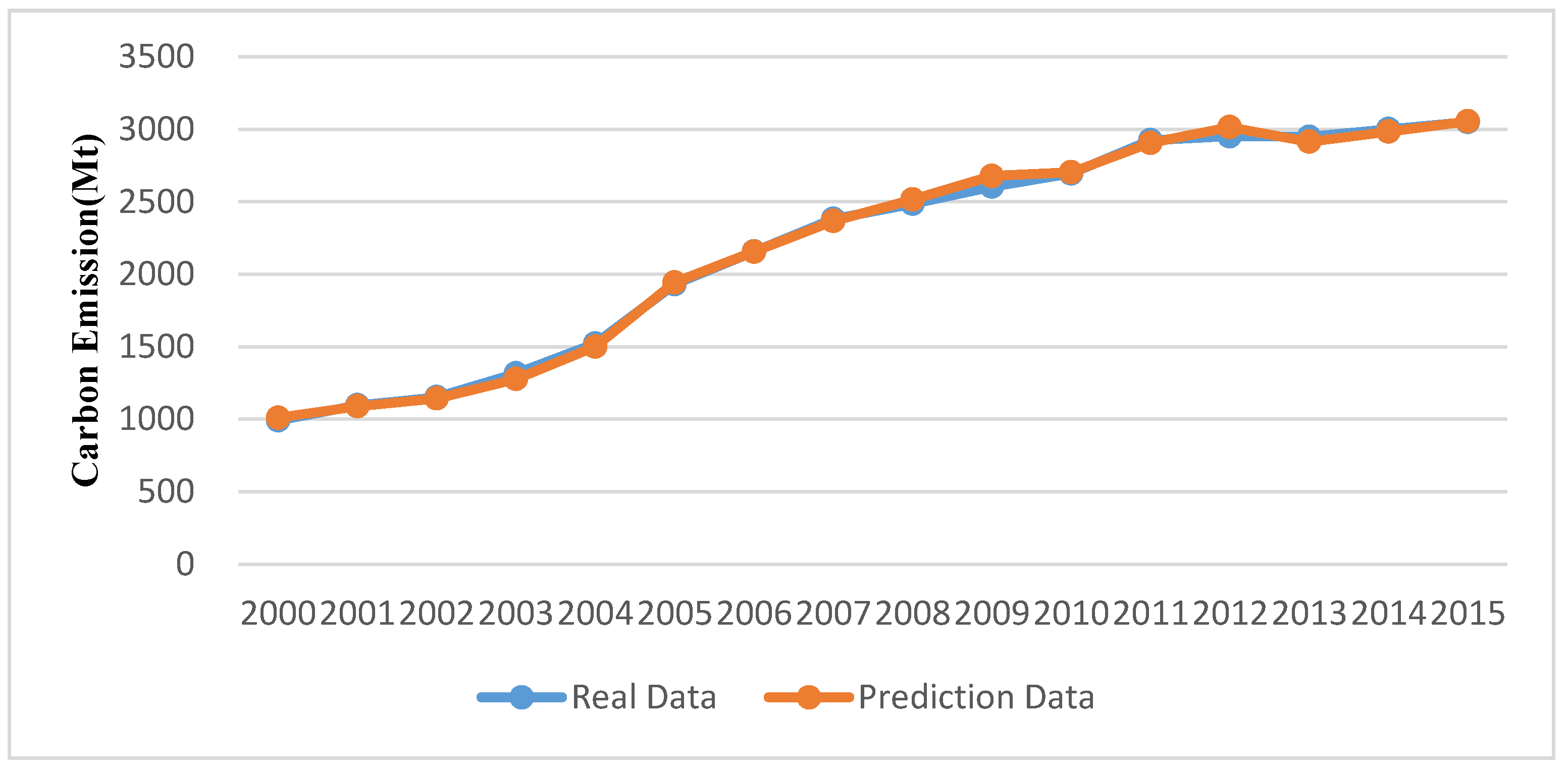1. Introduction
The world economy is developing rapidly, and China’s enormous role cannot be ignored. At present, China has become the second-largest economy worldwide. However, economic growth is always accompanied by a large amount of energy consumption, especially fossil fuels consumption. It is clear that Chinese carbon emissions are closely linked to the consumption of fossil fuels, which makes China the world’s largest carbon emitter, accounting for 23.4% of carbon emissions in the world [
1,
2]. Consequently, mitigation of the greenhouse effect has become an urgent issue in China. Several targets have been set by the government for conserving energy and reducing emissions. In December 2009, a CO
2 reduction target of 40–45% by 2020, compared to 2005 levels, was set by the government [
3]. In the “13th Five-Year Plan” (2016–2020), the government put forward specific indicators of National Economic and Social Development, in which energy efficiency and carbon intensity were proposed to be reduced by 15% and 18% in 2020 respectively, compared to 2016. In addition, in 2015, the Chinese government promised that carbon emissions would not rise no later than 2030, and carbon intensity would be reduced by 60–65% compared to 2005 [
4].
East and south coastal China, including Shandong, Zhejiang, Jiangsu, Shanghai, Fujian, and Guangdong (hereinafter referred to as “the Region” according to the research in Reference [
5]), is a cluster of the country’s most economically developed provinces. The Region contains the Yangtze River Delta, including Zhejiang, Jiangsu, Shanghai [
6], and the Pearl River Delta, including most areas of Guangdong [
7]. Because of its location along the coast, import and export trade promotes the growth of the regional GDP [
8]. In 2015, the Region’s GDP was 217610.8 BY, accounting for more than one half of the country’s total GDP. It was not only the first region to implement the reform and opening up policies, but also served as an experimental base for important national plans [
5]. Although the Region accounts for only a small portion of the country’s land, its population was 406.5 million and carbon emissions were 3252.2 Mt in 2015, which accounted for approximately one third of the national total [
9]. Therefore, the Region is extremely vital for estimating whether the country can achieve emission reduction targets.
For all that, there is little research on the Region for in-depth study. In this paper, six provinces in east and south coastal China were taken into consideration for analysis. We used the STIRPAT model to study the factors impacting carbon emissions. For the sake of developing a better understanding of the current state of development, this paper explored the Environmental Kuznets Curve (EKC) relationship of per capita GDP/urbanization and carbon emissions in the Region. In addition, according to the “13th Five-Year Plan”, four different scenarios were set up to predict the Region’s contribution to the national 2020 and 2030 emission reduction targets. In the light of the scenario analysis, this paper proposed several corresponding effective policy suggestions. In conclusion, this study was conducted to resolve following issues: firstly, to analyze the factors influencing carbon emissions, further verifying the existence of the EKC relationship; secondly, to predict the Region’s contribution to the national emission reduction targets; and thirdly, to put forward related policy recommendations.
The rest of this paper is structured as follows.
Section 2 provides the literature review.
Section 3 introduces the methodology and data sources.
Section 4 reports the results and discussions.
Section 5 gives the conclusions and policy implications.
2. Literature Review
For the choice of the research object, different studies have different emphases. Some studies selected diverse industries as research objects. Zhang et al. [
10] studied the factors impacting CO
2 emissions in the transportation sector. They found that the traffic activity effect was the main factor increasing energy consumption, while adjusting energy intensity effects could effectively reduce it. Wang et al. [
4] studied carbon emissions in high, mid, and low energy consumption sectors from 1996 to 2012, setting three scenarios to estimate whether 2020 and 2030 carbon emission targets could be reached, and corresponding policy recommendations were given to the sub-sectors. Meng et al. [
11] researched the relationship between CO
2 emissions and its influencing factors in the power industry from 2001 to 2013. They concluded that the government should optimize the industrial export structure and raise the awareness of household electricity saving to alleviate the carbon dioxide emissions of the electricity industry in the future. In addition, some studies selected different areas as research objects. For example, some studies concentrated on national carbon emissions (e.g., [
12,
13]). Wang et al. [
14] and Wang and Zhao [
15] studied the differences in the impact factors on carbon emissions in eastern, central, and western China. Song et al. [
6] and Yu et al. [
7] selected the Yangtze River Delta and the Pearl River Delta as the object of study, respectively. In detail, Song et al. [
6] used the LMDI model to analyze the driving effects of economic scale, population size, energy intensity, and energy structure on carbon emissions in the Yangtze River Delta. The implementation of targeted carbon reduction measures was found to help greatly reduce the national carbon emissions. Meanwhile, to a certain extent, the research method was also applicable to other specific regions in China. Yu et al. [
7] studied the impact of traffic control policies on O
3 emissions in the Pearl River Delta. The results of this study provided some basic information to help understand the impact of control policies on ambient O
3 in highly developed areas in China. In addition, some studies selected a single province as the object of study. Wang et al. [
16] conducted an econometric model to investigate carbons emission in Guangdong Province from 1980–2010. Xu et al. [
17] used the input-output relationship of the SDA model to discuss carbon emissions in Jiangsu. At present, only Gao et al. [
5] chose the Region as the research object, using the LMDI model to analyze the influencing factors of carbon emissions from 2000–2012.
Various methods were used by the existing studies on the impact factors of carbon emissions, among which logarithmic mean Divisia index (LMDI) and STIRPAT are two of the most commonly applied due to their strong applicability. Wang et al. [
4], Xu et al. [
18], and Yan et al. [
19] examined the affecting factors of national greenhouse gas emissions using the LMDI model. Guo et al. [
20], Liu et al. [
21], and Xin [
22] employed the LMDI model and the research objects they selected were Shanghai, Jiangsu, and Beijing, respectively. They all decomposed factors into the following categories: carbon emission coefficient, energy structure, energy efficiency, industry share, GDP. Liu et al. [
23], Lin and Long [
24], and Xie et al. [
25] applied LMDI and focused on the carbon emission indexes of different industries, including industrial, chemical, and petroleum coking industries, which decomposed factors into CO
2 emission coefficient, industry share, energy efficiency, average output, and industry size. However, the number of impact factors that the LMDI model can consider is limited, so this method does not allow multivariate analysis [
16]. The STIRPAT model, however, has fewer constraints on the selection factors than LMDI. Zhang and Tan [
12] employed the STIRPAT model to study the demographic factors influencing China’s carbon emissions, and these factors included adult illiteracy rate, higher education proportion, population intensity, population share, and the like. Salahuddin et al. [
26] used the STIRPAT model to analyze the impact factors of Internet use on carbon emissions in Organization for Economic Cooperation and Development (OECD) countries, and creatively selected the number of Internet users per 100 people as a technical factor. Tan et al. [
27] applied the STIRPAT model to predict the carbon emissions of 2020 and 2030 in Chongqing, in which the energy structure, industrial structure, and technological advancement were chosen to replace the technical factors (T) in the model. Compared to LMDI, the STIRPAT model has a wider range of factors selection, so the results are more comprehensive and convincing [
16].
Additionally, the EKC hypothesis for income and pollution can be traced back to the pioneering work of Grossman and Krueger [
28], who reported that pollution index and GDP had an inverted U-shaped relation. It is worth noting that the EKC has significant merits. Its inverted U-shape reflects that economic growth can promote environmental improvement. The prerequisite for this result is to implement effective environmental policies while raising the economic level [
29]. EKC has been widely used to estimate the current stage of development in the region. York et al. [
30] found that STIRPAT can accurately represent the functional form of the relation between emissions and economic growth. After that, a number of studies used STIRPAT to study the EKC relationship between GDP and carbon emissions. Diao et al. [
31] verified the EKC hypothesis concerning the economic level and carbon emissions of Zhejiang. Later, the research direction was related to the trend of urbanization and carbon emission, and further confirmed the development level of the researched region. Ouyang and Lin [
32] employed the STIRPAT model to compare the impact of urbanization on CO
2 emissions in China and Japan. He et al. [
33] found the inverted U-shape curve relation between urbanization and carbon emissions in different development level regions. Zhao et al. [
29] studied the EKC relationship and coupling analysis of urbanization and CO
2 emissions in the Yangtze River Delta. Therefore, in order to gain a better understanding of the development level, this paper explored the EKC hypothesis of per capita GDP/urbanization and carbon emissions in the Region.
According to the abovementioned research findings, this paper filled in three aspects of the research gap that have not been considered in the existing literature. Firstly, the study selected six provinces in the east and south coastal area as the research object, which played an important role in estimating national carbon emission reduction targets. Only one other article selected this Region as a research object, although it used LMDI to analyze the influence indexes of CO2 emissions. Because the selected factors of LMDI are limited, the analysis of factors impacting carbon emissions is not comprehensive. In this study, the STIRPAT method was used to study the factors influencing carbon dioxide emissions in the Region, which made up for the limited selection of factors. Also, we verified the EKC hypothesis between per capita GDP/urbanization and carbon emissions in order to further understand the current development stage. Furthermore, taking into account the importance of the Region, this study predicted the contribution of this Region to the national 2020 and 2030 emission reduction targets. Based on the three ordinary scenarios, the highest-rate scenario was innovatively added, based on the highest growth rate of historical data. This scenario served as a basis for reality. Finally, more applicable and effective policy recommendations for reducing CO2 emissions in the Region were proposed.
5. Conclusions and Policy Implications
This paper conducted a multivariate analysis of carbon emissions in east and south coastal China from 2000–2015, an area that includes six provinces named Shandong, Zhejiang, Jiangsu, Fujian, Shanghai, and Guangdong. We used the extended STIRPAT model to study impact indexes of carbon emissions. The factors included population, per capita GDP, urbanization, energy efficiency, and industrial structure. What is more, in order to understand the development status more comprehensively, we further verified the EKC hypothesis between per capita GDP/urbanization and carbon emissions. Finally, we forecasted carbon intensity in this area and identified its contribution to the national emission reduction targets in 2020 and 2030. Considering the significance of per capita GDP, energy intensity, and industrial structure obtained from regression results, four scenarios were set to predict the carbon emissions of the area according to the respective growth rates of three factors.
The regression results showed that the population was the most prominent factor. Its change trend was steady, so it had little impact on carbon emissions. Economic growth played a significant role in increasing carbon emissions, while energy intensity was mainly responsible for reducing it. The negative effect of industrial structure was not obvious, so there was a much room for improvement. As for the EKC hypothesis, the relationship between per capita GDP/urbanization and carbon emissions exhibited an inverted U-shape, which can satisfy the logical support EKC hypothesis and ecological modernization theory. Analysis results showed that, in the BAU scenario, the carbon intensity was reduced by 48.5% in 2020 and 59.7% in 2030 compared to 2005, but in the advanced scenario, the carbon intensity was reduced by 51.7% in 2020 and 69.1% in 2030 compared to 2005, which contributed greatly to the national carbon emission reduction targets. From the highest-rate scenario, it can be seen that improving energy efficiency, optimizing energy structure, and adjusting industrial structure can effectively reduce carbon intensity.
Based on the results mentioned above, the future strategies of carbon emission mitigation for policymakers are provided below:
(1) Increasing the emission reduction effect of energy efficiency. Looking to the future, the Region’s GDP will maintain fast growth. It was unreasonable to decrease CO2 emissions by decreasing the GDP growth rate. Admitting this fundamental problem meant we need to take other measures to reduce CO2 emissions. Energy efficiency and per capita GDP were the significant factors affecting carbon emissions, but the reduction of energy intensity had yet to be strengthened. Technological progress and innovation can greatly improve energy efficiency, and we should be committed to developing and introducing advanced technology.
(2) Optimizing the energy structure is imminently needed. The energy structure of the Region is dominated by coal. In order to reduce environmental pollution, the Region can continue to optimize the energy structure. It should minimize the proportion of coal in energy use, and speed up the innovation of coal-utilization technology, such as clean coal technology, as well as increase the use of oil, natural gas, and other clean energy. In addition, the Region should vigorously encourage new energy power generation methods, such as solar, hydro, wind, nuclear, and biomass energy generation. As the Region’s main generating power is thermal, the fuel consumption of thermal power accounted for 50% of total fuel consumption; this should be considered as a serious issue.
(3) Encouraging the optimization of industrial structure. It was found that industrial structure remarkably decreased CO2 emissions in the MS and AS. Although the Region includes the six most developed provinces in the whole country, the proportion of secondary industry GDP is still rising year by year. The Region’s secondary industry accounted for 50% of the national secondary industry GDP, while the manufacturing industry output accounted for more than 70% of the country’s GDP. Enterprises with high consumption, pollution, and carbon emissions were the major sources of CO2 emissions. Hence, in order to create green ecological cities, it is very important to transform and upgrade industrial structure. Innovative technologies should be advocated in existing industries, while green energy-saving industries could energetically advance the effectiveness of resource distribution and improve fuel utilization. What is more, many Chinese companies do not realize the mutual benefit of decreasing emissions by cooperation with other companies. Especially for high energy-consuming industries, enterprises should realize that energy conservation and environmental protection can be achieved by industrial symbiosis. In addition, due to the different development levels of the six provinces in the Region, different strategies should be adopted for different provinces.
This paper provided a new avenue through which researchers can further explore carbon emissions in specific areas. The EKC curve combined with the econometric model was used to explore the relationship between per capita GDP/urbanization and carbon emissions in specific areas. Based on the traditional scenario settings, the highest-rate scenario was added to predict carbon emissions more comprehensively. However, there are some limitations in this study. Although our current research results are encouraging, we tend to be cautious. In the respect, we look forward to further study, including new indexes and different angles, to conduct a more in-depth investigation of the carbon impact factors in the Region. Meanwhile, there are certain limitations to the study of specific areas to assess whether the national carbon reduction targets can be achieved.











